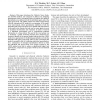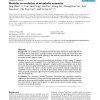10 search results - page 1 / 2 » Duplication of Modules Facilitates the Evolution of Function... |
ALIFE
2000
13 years 4 months ago
2000
The evolution of simulated robots with three different architectures is studied in this article. We compare a nonmodular feed-forward network, a hardwired modular, and a duplicatio...
JCB
2000
13 years 4 months ago
2000
Large scale gene duplication is a major force driving the evolution of genetic functional innovation. Whole genome duplications are widely believed to have played an important rol...
CEC
2007
IEEE
13 years 11 months ago
2007
IEEE
Abstract— This paper introduces the Collective Neuro Evolution (CONE) method, and compares its efficacy for designing specialization, with a conventional Neuro-Evolution (NE) me...
BMCBI
2007
13 years 4 months ago
2007
Background: The architecture of biological networks has been reported to exhibit high level of modularity, and to some extent, topological modules of networks overlap with known f...
JCNS
2000
13 years 4 months ago
2000
We explore a computationally efficient method of simulating realistic networks of neurons introduced by Knight, Manin, and Sirovich (1996) in which integrate-and-fire neurons are ...


